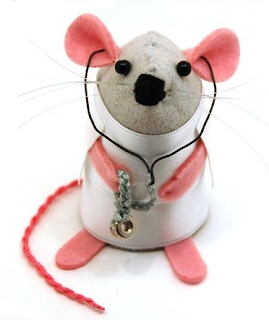Some time ago, we had a mouse problem at our house.
Now, by “mouse problem” I do not mean that I was unable to beat my wife's high score on Windows Solitaire because the tracking ball on the mouse kept getting stuck. Nor do I mean that a mouse may have been politely poking her head through a hole in the wall and demurely offering to come back later if this was a bad time to come visit.
“Ooh,” we did not coo. “You adorable little thing! You must be starved. Here, have some peanut butter and crackers.”
No, we had a problem.
I would be working at the computer and from behind me I would hear not the pitter-patter of little feet, but the skitter-skitter of tiny paws. Sometimes instead of paws I would hear tiny teeth gnawing away at the wooden struts inside the walls, or at things that had fallen unnoticed to the floor at the back of the pantry and remained there unseen. We would be abed, and my wife, a far lighter sleeper than I, would hear an unwanted guest scurrying across the floor.
This was no dramatization of Aesop's fable. The city mouse hadn't merely invited the country mouse to come visit her in the city. She had arranged a full family reunion from Uncle Sid to distant cousin Yeta, with our house the grand hotel, safe from the feral cats that wander through our back yard.
Admission to the family reunion cost only $200, and came complete with access to an open bar and presentations on the history of the mouse family, from the time Uncle Webster and Cousin Cyrus spread plague the length of the Ohio River down to the present breakthroughs in spreading leptospirosis.
There was a time when we would have made a trip to the store and bought some poison. I'd have opened the boxes and placed them in strategic places where the children wouldn't see them, and where the dog couldn't get them. The mice of course would discover them and perform a tarantella in wonder over this unexpected bonanza of delicious green pellets, right up until they died of thirst, preferably outside.
Changing rules and concerns over the wisdom of putting such poison in the hands of homeowners meant that we could no longer buy the poison ourselves, so we called an exterminator. He came, sized up the problem, and made us an offer.
“I can set some poison and get rid of them for two hundred dollars,” he said.
That's a lot of money for something you'd like to think that you can do for yourself. So we resorted to traps, which after all are a fairly straightforward affair. You bait the trap, the bait attracts the mice, and the mice die. Maybe they fall into a bucket of water and drown, maybe they walk over glue and get stuck, or maybe they trigger a spring and it all ends with a loud snap. As long as it ends with a dead mouse, it's a story with a happy ending.
Alas, I failed to consider the role of evolution and the population pressures that humans have been applying to mice since time immemorial.
It's a principle of evolutionary theory that species adapt to changes in their environment, and each generation is slightly different from the one before it, and therefore harder to get rid of. Antibiotics eventually produce superbugs that are virtually unstoppable. Head lice develop a resistance to the insecticide that we place in delousing shampoo.
And mice? Ever since "Tom and Jerry" debuted, they've been getting uppity. They've learned to outrun the cat, and now they're figuring out how to avoid traps.
I set up a bucket of water in the basement, a tin can smeared with peanut butter, resting on a metal rod over the middle of the bucket. The idea is that a mouse will climb the ramp to the rim of the bucket, walk out into the middle to get the peanut butter, and then roll into the water and drown.
The mice weren't having it.
We set glue traps. In the morning the traps had paw prints on them, next to what I only can assume was mouse script for “Calvin was here,” written in the glue with tiny sticks.
We also set the traditional spring-loaded traps that go snap in the night. These proved to exert the biggest population pressures of all. After we eliminated the mice that were stupid enough to set off the traps, we were left with a mouse population of gradually increasing intelligence.
At first the smarter mouse would convince his companion to run across the trap and see if it was armed, and then eat the bait. After this had gone on a few months, the surviving mice, born from the intelligent mice, had wised up to this trick, and formed a union to protest their unsafe work conditions. That in turn led to exploratory committees that investigated ways to get the food without setting off the traps, and even administrative requirements that the mice forage where there were no traps at all.
It seemed like it was all over at that point. Mouse unions had bettered the working conditions and livelihood of everyone but the people trying to kill them.
Deliverance came, of all things, from plaster of paris. Apparently if you thoroughly mix a cup of it with a cup of all-purpose flour, you create a lethal combination. Drawn to the flour, mice also will eat the plaster of paris, which turns to rock in their guts and kills them. You can add milk if you want, to create dough balls, but either way intestines of rock apparently are detrimental to a mouse's good health.
Problem solved.
At least until the next evolutionary leap.
Copyright © 2017 by David Learn. Used with permission.
Tweet
Friday, November 03, 2017
Subscribe to:
Post Comments (Atom)

No comments:
Post a Comment